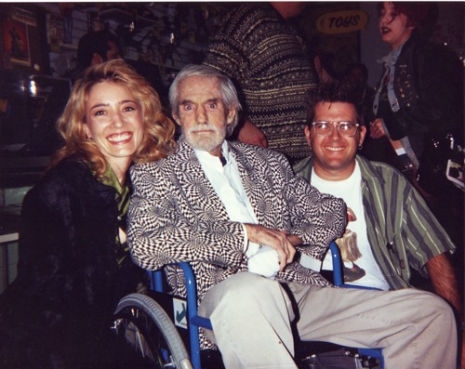
Timothy Leary with Boing Boing founders Mark Frauenfelder and Carla Sinclair at Golden Apple Comics. Photo: Richard Metzger
At some point in 1995, I was visiting Dr. Timothy Leary in his home in Benedict Canyon. I showed up at the appointed time and waited outside on the patio.
And I waited. And waited. And waited and waited and waited. After about an hour and 45 minutes—the guy was one of my greatest heroes, how long are you supposed to wait in a situation like that?—I made to leave when Tim finally arrived. It had been some time, maybe five years, since I had seen him last and he looked terrible. Until recently Leary could have passed for a man 20 years younger, but now he looked just awful. It was the week before he told the media that he had terminal cancer.
That day, a delivery of several boxes of items which had been confiscated during one of his many drug busts of the sixties, had arrived at the house. There were several people in the housre cataloging the contents (one of them was Bill Daily, the antiquarian book dealer here in Los Angeles and I think former SNL comedy writer Tom Davis might have been there, too).
One item had the group on stitches when it was discovered: A tin flour container (my grandmother owned the exact same one) full of flour. It was surmised by the group that whoever grabbed it must have suspected the flour jar was where the cocaine was hidden. I recall Leary quipping “I wonder where they thought we kept our flour?”
It’s taken over a decade since Leary’s death, but yesterday an article in the New York Times reports that Leary’s personal papers have been acquired by the New York Public Library:
When the Harvard psychologist and psychedelic explorer Timothy Leary first met the Beat poet Allen Ginsberg in 1960, he welcomed Ginsberg’s participation in the drug experiments he was conducting at the university.
Multimedia
“The first time I took psilocybin — 10 pills — was in the fireside social setting in Cambridge,” Ginsberg wrote in a blow-by-blow description of his experience taking synthesized hallucinogenic mushrooms at Leary’s stately home. At one point Ginsberg, naked and nauseated, began to feel scared, but then “Professor Leary came into my room, looked in my eyes and said I was a great man.”Ginsberg’s “session record,” composed for Leary’s research, was in one of the 335 boxes of papers, videotapes, photographs and more that the New York Public Library is planning to announce that it has purchased from the Leary estate. The material documents the evolution of the tweedy middle-aged academic into a drug guru, international outlaw, gubernatorial candidate, computer software designer and progenitor of the Me Decade’s self-absorbed interest in self-help.
The archive will not be available to the public or scholars for 18 to 24 months, as the library organizes the papers. A preview of the collection, however, reveals a rich record not only of Leary’s tumultuous life but also of the lives of many significant cultural figures in the ’60, ’70s and ’80s.
Robert Greenfield, who combed through the archive when it was kept in California, for his 2007 biography of Leary, said: “It is a unique firsthand archive of the 1960s. Leary was at the epicenter of what was going on back then, and some of the stuff in there is extraordinary.”
Leary, who died in 1996, coined the phrase “Turn on, tune in, drop out” and was labeled by Richard M. Nixon as “the most dangerous man in America.” He was present in Zelig-like fashion at some of the era’s epochal events. Thousands of letters and papers from Ginsberg, Aldous Huxley, William Burroughs, Jack Kerouac, Ken Kesey, Charles Mingus, Maynard Ferguson, Arthur Koestler, G. Gordon Liddy and even Cary Grant — an enthusiastic LSD user — are in the boxes.
Thank you Douglas Rushkoff!